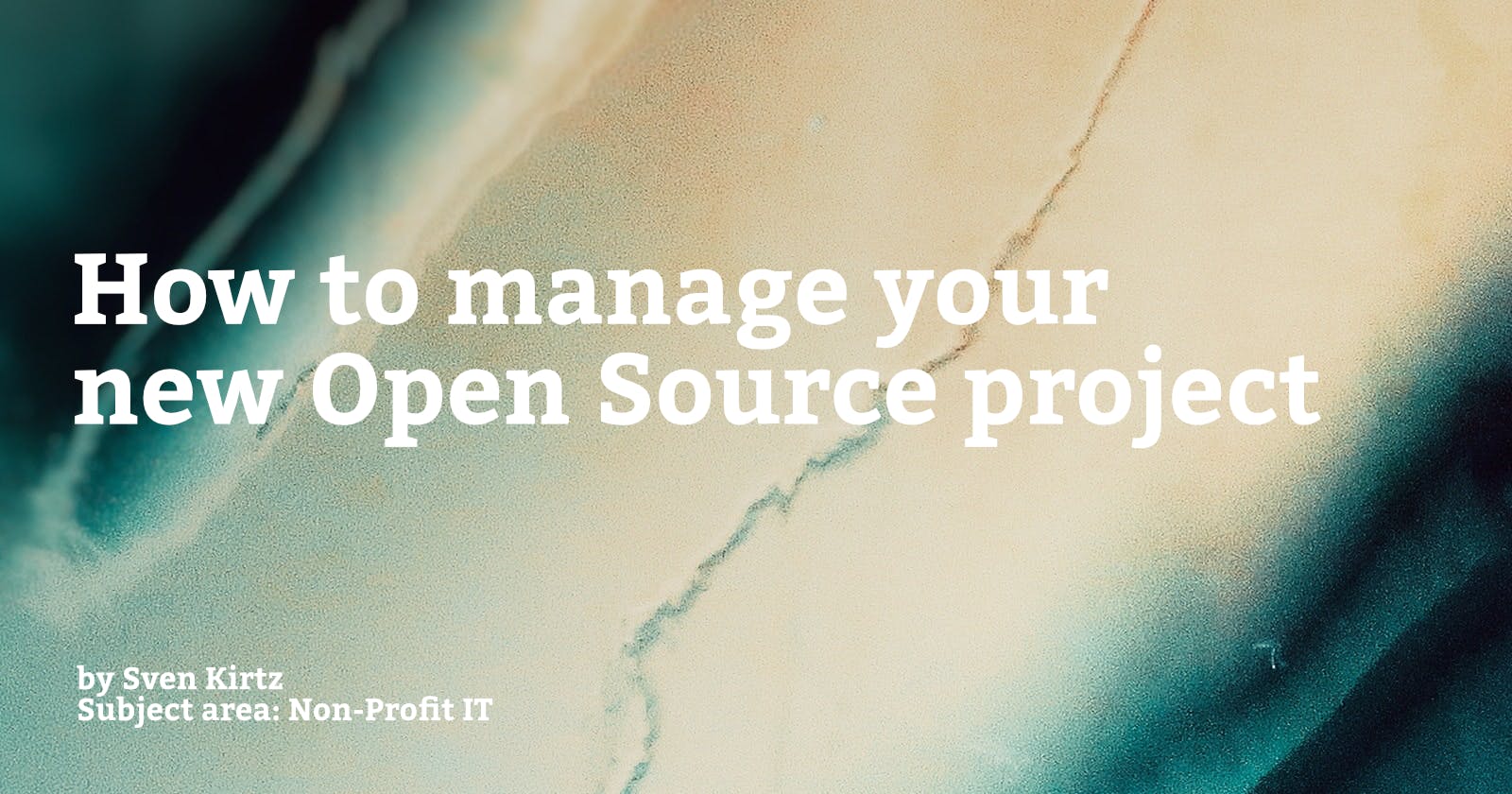How to manage your new open source project
The wide variety of open source projects
The 3 conditions of open source
For an open source project to happen, these conditions have to be met (PAN, 2016, p. 481):
🌐 reliant on the internet
🤸 implementing a user-developer innovation process
🧩 a highly modular design
Due to their great diversity, open source projects cannot be categorized.
One of the many possibilities is Schrape's definition of ideal-typical variants. Schrape categorizes open source projects according to their corporate influence and hierarchical organizational structure (cf. Schrape, 2015, p. 33).
Peer Production Communities
The greatest freedom can be expected in peer production communities. These are the projects that are the closest to Richard Stallman's idea for FOSS. They have an egalitarian organizational structure and commit themselves to socio-ethical maxims without corporate influence (cf. SCHRAPE, 2015, p. 33).
If you want to create a Peer Production Community, you need :
A balanced mix of intrinsic and extrinsic motivation: Track the motivation of your contributors. Keep them engaged and create well-balanced incentives to collaborate.
A cultivated hacker culture: Allow your contributors to be nerdy, let them create memes and create a welcoming atmosphere within your project.
Strict rules for cooperation: You need strong, clear rules so that your participants do not feel exploited, e.g. with copyleft licenses (see PAN, 2016, p. 481).
Elite-centric project communities
If you want to know what it's like to be a dictator make your project an elite-centric project.
Elite-centered project communities have also a weak corporate influence, but a narrowly defined leadership circle. Often their founders are at its head (cf. SCHRAPE, 2015, p. 40). According to Raymond, groups consisting of developers and project leaders will merge into an organization with a "benevolent dictator".
The dictator must always have the common good of his project and community in mind to prevent forks of the project. Even if the owner remains dictator, he introduces a level of possible discussion about who is credited with authorship for which parts of the project. Thus, the owner should not own his project absolutely, even though he retains the right to make binding decisions (cf. RAYMOND, 2000).
Heterarchical infrastructure projects
If you have already an established organization, you can create a heterarchical infrastructure project. This kind of project is usually associated with foundations.
Although there are significant differences in the governance of these projects, they retain the characteristic that anyone can participate in any project as a member of the community.
Most of these foundations have created licenses for the use and distribution of their software. These foundations receive funding from corporations and other funders to cover the costs of project infrastructure and foundation management. This funding, combined with the screening of the various projects, attracts a larger community of developers (see WASSERMAN, 2013, pp. 3-4).
Corporate-led collaboration projects
If you're having a startup and want to make profit with your project, there's an open source way too.
Corporate-led collaboration projects are under a strong or total corporate influence and are often managed in a strict corporate-led hierarchy (cf. SCHRAPE, 2015, p. 37).
„If a software firm can encourage voluntary external work, its development costs decrease, because in these situations the firm does not have to pay for the external contributions. Many firms increasingly initiate their open source projects rather than building on existing ones.“ (Schaarschmidt et al., 2015, S. 100)
However, "given the dominance of employed developers, [...] project-related collaboration with other industrial stakeholders" (SCHRAPE, 2015, p. 34) has become the focus.
Conclusion
You should choose how you manage your open source project depending how you see yourself as a person and what people you want to work with.
Sources
The Linux Foundation: Linus Torvalds: Why a Career in Linux and Open Source. Available online at https://www.youtube.com/watch?v=s8EKVNcD1ko.
GitHub (2018): The State of the Octoverse. Available online at https://octoverse.github.com/, last updated Nov. 17, 2018, last checked Feb. 14, 2019.
Schrape, Jan-Felix (2015): Open source software projects between passion and calculation (SOI Discussion Paper) (02). Available online at http://www.uni-stuttgart.de/soz/oi/publikationen/soi_2015_2_Schrape_Open_Source_Softwareprojekte_zwischen_Passion_und_Kalkuel.pdf.
Pan, Xiangdong (2016): A New Method of Production: peer production. In Menggang Li, Qiusheng Zhang, Juliang Zhang, and Yisong Li (eds.) Proceedings of 2015 2nd International Conference on Industrial Economics System and Industrial Security Engineering, vol. 327. Singapore: Springer Singapore, pp. 477-484.
Raymond, Eric S. (2001): The cathedral and the bazaar. Reflections of an accidental revolutionary on Linux and open source. Rev. ed. Beijing, Cambridge Mass: O'Reilly.
Wasserman, Anthony I. (2013): Community and Commercial Strategies in Open Source Software. In: it - Information Technology 55 (5). DOI: 10.1515/itit.2013.1003.
Schaarschmidt, Mario; Walsh, Gianfranco; Kortzfleisch, Harald F.O. von (2015): How do firms influence open source software communities? A framework and empirical analysis of different governance modes. In Information and Organization 25 (2), pp. 99-114. DOI: 10.1016/j.infoandorg.2015.03.001.
Angelopoulos, Christina (2012): The myth of European term harmonization: 27 public domains for the 27 member states. In: SSRN Journal. DOI: 10.2139/ssrn.2145862.
Richard Stallman (2014): Why Upgrade to GPLv3. Ed. v. Free Software Foundation. Available online at https://www.gnu.org/licenses/rms-why-gplv3.html, last visited February 14, 2019.
Free Software Foundation (2019): Miscellaneous licenses and comments. Available online at https://www.gnu.org/licenses/license-list.html, last verified 14 Feb. 2019.
Donald Robertson (2015): Demystifying copyleft - Free Software Foundation - working together for free software. Ed. v. Free Software Foundation. Available online at https://www.fsf.org/bulletin/2015/spring/demystifying-copyleft-1, last visited February 14, 2019.

